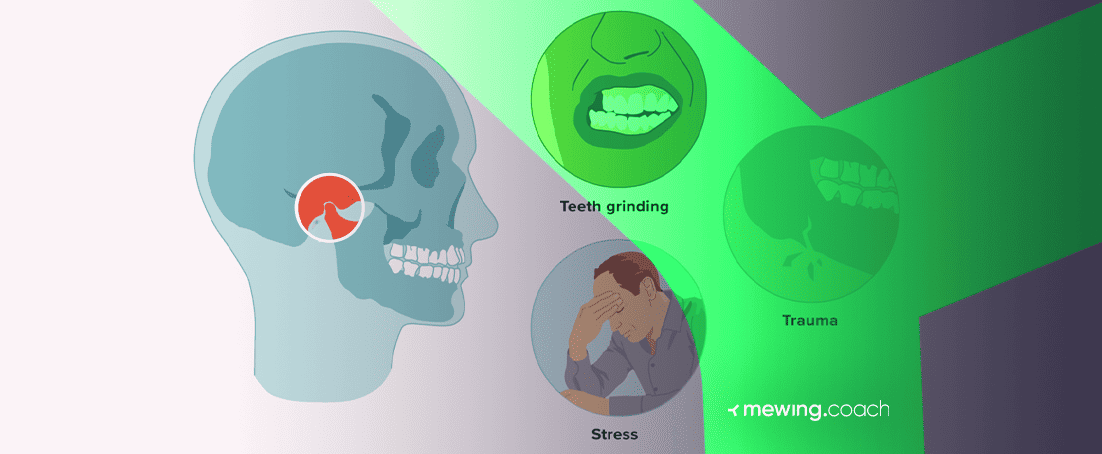Hypermobility is a relatively common problem among young people. It directly affects the connective tissue proteins responsible for rigidity, resulting in looser connective tissue and overly relaxed joints. People with hypermobility spectrum disorders are often referred to as double-jointed because of the fact that their joints tend to have a wider range of motion than normal.
Hypermobility can affect all joints throughout the body, including the temporomandibular joint. TMJ hypermobility is characterized by an excessive or early forward gliding of one or both jaw joints, resulting in a number of painful and disruptive problems. This excessive mobility of the jaw may or may not be linked to other forms of jaw misalignments.
It is most prevalent in young women, and the main culprit is a hormone known as relaxin. Keep reading to learn more about:
- 📝 Symptoms
- 📝 Causes, and
- 📝 Treatment of jaw joint hypermobility syndrome.

Symptoms of the Hypermobile Mandible
Hypermobile TMJ symptoms are similar to those of other temporomandibular joint disorders. They can range anywhere between mild pain and discomfort to severe chronic pain and other disruptions in speech, eating, or functioning.
There are other symptoms as well, but let’s take a closer look at some of the most common ones:
-
Chronic jaw pain or discomfort in the jaw, face, or neck
Orofacial pain and discomfort in the jaw, neck, and face are common side effects of temporomandibular joint hypermobility syndrome. This pain and discomfort can disrupt one’s daily routine, causing trouble sleeping and difficulty concentrating and functioning in day-to-day activities. Individuals experiencing jaw hurts after sleeping may also encounter such discomfort. Pain medication can offer brief and temporary pain relief, but to really cure these symptoms, a person must address the underlying problem.
-
Difficulty biting or chewing food
The disrupted joint movement can lead to difficulties when biting or chewing food, especially if the food is hard. Biting and chewing can also cause severe pain to the extent that eating becomes nearly impossible.
-
Difficulty speaking or making certain sounds
In order to produce certain sounds and to speak clearly, a person must have full control over their mouth. Because hyper joint mobility causes you to lose control over your jaw and muscles, speech can also be impaired.
-
Chronic headaches or migraines
Due to the fact that headaches are a common symptom of a variety of health problems, they are often overlooked signs of hypermobile jaws. But headaches and migraines are frequent symptoms of this condition.
-
Tension or pain in the neck and shoulders
Patients with hypermobility jaw problems often experience tension or pain in the neck and shoulder area. This symptom is also associated with a number of other conditions and can easily be overlooked.
-
Visible misalignment of the jaw or teeth
Sometimes temporomandibular joint hypermobility can cause a visible misalignment of the jaw or teeth. People with EDS (Ehlers-Danlos Syndrome) often experience temporomandibular joint dislocation and mandibular lateral displacement- a sideways protrusion of the lower jaw.
-
Popping or clicking sounds when moving the jaw
People with temporomandibular joint dysfunction often experience popping or clicking sounds when they move their jaws or try to open their mouths. This symptom is almost always a definite sign of TMD.
Causes of Jaw Hypermobility
Hypermobility in the temporomandibular joint can be caused by a number of factors. Some of them are internal, like genetic predispositions for a certain medical condition like Ehlers-Danlos Syndrome or Marfan syndrome, and some are external, like trauma, injury, or improper development.
Developmental issues
Development is a huge factor in any condition. Just as proper development can facilitate normal growth and positive outcomes, improper development can hinder it. Poor posture, insufficient diet, and bad habits can lead to a number of temporomandibular disorders. Chewing too much gum, nail-biting, teeth grinding, or bad mouth posture can all contribute to the development of temporomandibular joint hypermobility syndrome.
Trauma or injury to the jaw
People who’ve suffered some sort of trauma or injury to their jaw can also experience temporomandibular joint dysfunction and hypermobility disorder in the temporomandibular joints.
People usually experience this type of trauma after going through a car accident or suffering a fall, an industrial accident, a sports injury, or a physical assault on the face.
Medical conditions
Certain medical conditions, especially those affecting proteins responsible for normal joint function, are major risk factors for developing hypermobility disorders. Such connective tissue disorders are Ehlers-Danlos syndrome and Marfan syndrome.
Ehlers-Danlos Syndrome
Ehlers-Danlos Syndrome is a spectrum of hereditary conditions that affect the production of collagens and certain proteins responsible for creating and maintaining connective tissue throughout the body.
There are 13 groups of Ehlers-Danlos syndromes, and hypermobility syndrome is the most common one. It affects women more so than men, causing a range of joint and muscle problems, including temporomandibular joint dysfunction. This is a serious condition that requires medical treatment, and time usually makes symptoms worse.
Marfan syndrome
Marfan syndrome is a similar hereditary disorder that impacts proper joint and connective tissue function. People with this condition typically display a range of visible signs. They are usually extremely tall and slender with disproportionately long extremities.
Marfan syndrome includes a variety of skeletal, ocular, and cardiovascular defects, including TMJ syndrome.
Malocclusion
Improper alignment of the teeth and jaws, otherwise known as malocclusion, can also lead to temporomandibular disorders and TMJ hypermobility.
Bruxism
Another cause for hypermobility and TMJ problems is constant grinding, gnashing, or clenching of the teeth, a condition otherwise known as bruxism.
Bruxism is usually caused by severe anxiety and stress and, if left untreated, can lead to a serious temporomandibular disorder, painful masticatory muscles, and even loss of teeth.
Treatment Options for Hypermobile Jaw
Once temporomandibular joint hypermobility syndrome sets in, it’s very difficult to find a cure, which is why prevention is very important. There are a few hypermobile jaw joint treatment options that have proved helpful with pain management and restoring the normal position of the jaws.
Some of these treatments are natural and minimally invasive, such as physical therapy or splint therapy, while others involve surgical procedures to correct the TMJ problem and restore the normal position of the jaw. People who have been diagnosed with Ehlers-Danlos syndrome and those who experience severe joint pain or facial pain will require medication as well.
Non-Surgical Options
As far as non-surgical jaw hypermobility treatment options go, physical therapy administered by a professional physical or occupational therapist is one of the best solutions. During physical therapy, patients typically work on mouth opening and jaw muscle strength and undergo treatment with ultrasound, moist heat, and ice.
Other treatments include splint therapy, medication, and the practice of proper oral posture, nowadays known as mewing. Find jawline exercises that work to improve your temporomandibular joint range of motion and muscle tone.
Mewing
If you’re not familiar with the term, mewing is the practice of proper tongue and mouth posture that promotes good oral health and teeth and jaw alignment. If you need more information on the topic, we’ve got mewing explained right here!
Many people have experienced various mewing benefits firsthand and can vouch for the amazing restorative effects the practice has for all jawline angles and shapes. There are a number of mewing techniques for jawline improvement that can help you ease your jaw pain, improve your temporomandibular joint mobility, bring more muscle tone to your face, and aid with other symptoms.
If you are experiencing acute jaw pain, it is probably wise to consult your doctor or another medical professional before incorporating mewing into your treatment plan, just to make sure you are not doing any harm.
To keep up with your practice and to make sure you stay on track, as well as learn new techniques and exercises, check out the Mewing.coach app. It features built-in reminders so that you never miss another day of mewing!
Splints or Mouth Guards
Another common temporomandibular joint hypermobility treatment is with splints or mouthguards. This form of treatment is always done under the close supervision of a dentist or an orthodontist who prescribes the splint or the mouthguard.
Splints are removable dental appliances usually made of hard acrylic resin. They are meant to be worn during the day or at night to improve teeth and jaw alignment and thus treat any potential or existing temporomandibular disorders or temporomandibular joint hypermobility.
Medications
In cases where over-the-counter pain meds are not enough to relieve jaw pain or jaw muscle pain, a doctor or a dentist may prescribe other painkillers or anti-inflammatory meds to reduce pain and swelling.
Often, when people experience muscle spasms due to TMJ problems, a doctor can prescribe muscle relaxants for a few days or weeks to relieve jaw muscle pain caused by the spasms.
And in some cases, a doctor may even prescribe tricyclic antidepressants that, in small doses, can act as pain relievers and help keep bruxism at bay.
Surgical Options
There are a few surgical procedures available for treating hypermobile jaw symptoms. However, like with any other surgery, the procedures carry increased risk factors. For this reason, the doctor must extensively review medical history and perform a physical examination to make sure a patient is fit to endure the procedure. Unfortunately, even in completely healthy young individuals, success is not guaranteed.
If the surgery is successful, patients will also need to go through recovery, which can be quite painful and time-consuming. It goes without saying that surgeries are extremely important and necessary in many cases, but they are best to be avoided when possible, which further emphasizes the importance of preventative care and easy weak jawline fixes.
People who suffer from temporomandibular joint hypermobility syndrome typically undergo two types of surgeries, orthognathic surgery or jaw joint surgery:
Orthognathic Surgery
Orthognathic or more commonly known as simply jaw surgery, is performed to correct the alignment of the upper jaw (maxilla) and lower jaw (mandible).
This is a long-term procedure that involves a lengthy preparation process and recovery that can last up to several weeks. Before surgery, patients usually have to wear braces for 12 to 18 months to prepare the teeth and jaws. Once the surgery is performed, normal recovery will entail pain, swelling, and difficulty eating in the first few days or weeks. After recovery, patients need to wear mouthguards again to prevent the jaws from going back to their pre-operation position.
As with any other surgery, there is a long list of possible risks, including blood loss, infection, nerve damage, jaw fracture, and more.
Jaw Joint Surgery
Jaw joint surgery is specifically aimed at treating the temporomandibular joint. There are two types of jaw joint surgery used to treat temporomandibular joint hypermobility:
- Arthroscopic jaw surgery
- Arthroplasty – Total Joint Replacement Surgery
Arthroscopic jaw surgery is the less invasive of the two. This surgery is typically performed under general anesthesia and involves two small incisions near the ear where the temporomandibular joint is located. Through these incisions, the surgeon inserts a narrow port through which they can directly inspect the joint and insert medication such as pain relief and steroids.
Arthroplasty, or total joint replacement surgery, on the other hand, is a more invasive procedure that involves removing the entire damaged jaw joint and replacing it with an artificial TMJ, usually made from titanium and high-density plastic.
This surgery is reserved for rare cases where it’s absolutely necessary, and it includes a long preparation, thorough physical examination, and a painful recovery period that requires a 3 to 5-day hospitalization.
The surgery itself takes three to four hours to complete and entails a number of risks that range from mild infections to bone loss and severe long-term damage.
Conclusion
Jaw joint hypermobility syndrome is a serious condition that can endanger the quality of life of the person who has it. Finding appropriate treatment is very important when dealing with any temporomandibular disorder, especially when it comes to jaw joint hypermobility.
People should not underestimate the value of preventative care and proper development and try to incorporate good oral practices into their everyday lives. Oral and maxillofacial surgery should always come as a last resort. In the meantime, mewing can provide all the benefits you need to ensure your jaws stay healthy!




